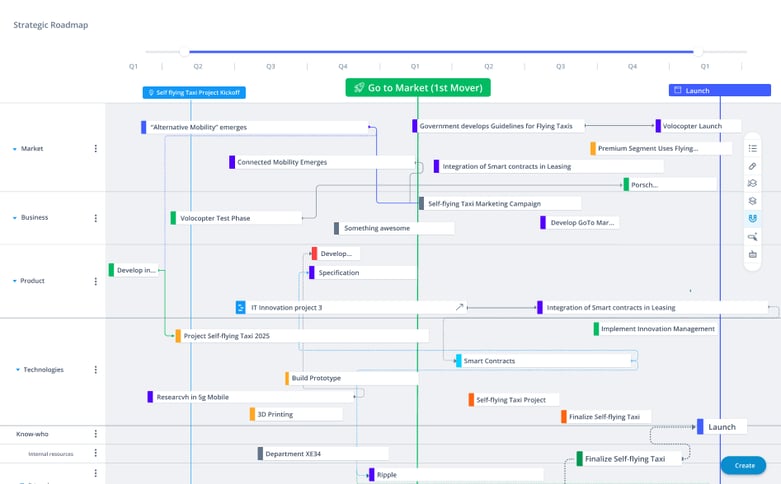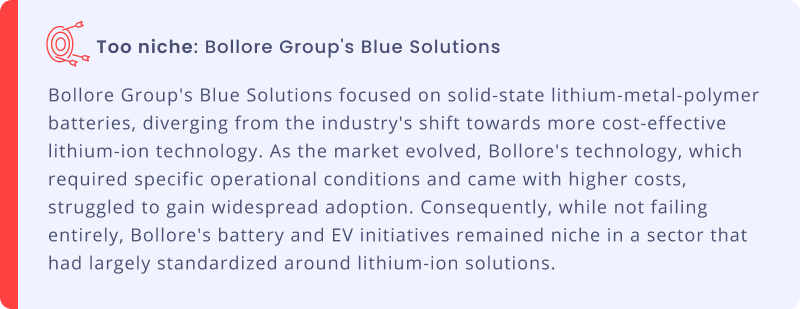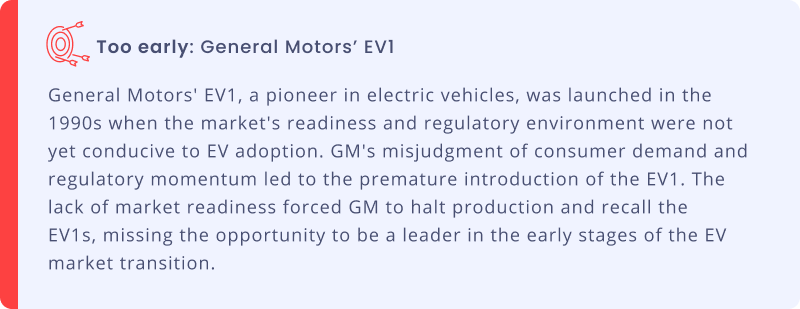Timing is everything. It’s the difference between Friendster and Facebook, Webvan and Instacart. Everyone remembers the Apple iPod, but few recall its predecessor, the Diamond Rio MP3 player.
These examples confirm that timing in the market isn't just about being first; it's about being right. And that being too early can be just as detrimental as being too late—as consumers may not be ready, or the technology may not yet be scalable for widespread adoption.
The companies that have mastered the art of timing in innovation do so by continuously scanning and interpreting signals of change in their environment. A blend of market insights, trend analysis, and foresight enables them to validate their go-to-market strategies, capitalizing on emerging opportunities while mitigating risks.
This blog delves into how discerning and acting upon the right signals at the right time paves the way for innovation success. From timing your go-to-market strategy to what signals of success to look out for, this guide presents best practices for introducing innovations. Not just when they're technologically feasible but when the market is psychologically and economically ready to embrace them.
Timing your go-to-market strategy
Imagine spending years developing an innovative product, only for poor timing to see it overlooked while competitors succeed. This scenario can lead to wasted time and money in real terms—as well as in future profit potential due to missed market opportunities.
The key to unlocking market success is not just in the innovation itself but in mastering the go-to-market strategy by recognizing and responding to the right signals. These signals can come from various sources and need to be interpreted quickly and accurately.
To ensure product launches synchronize with peak market readiness, innovation and portfolio managers should follow a strategic approach that includes continuous market analysis, agile planning, and responsive adaptation to evolving market conditions.
Automate signals monitoring
In today's fast-paced market, manually tracking changes isn't enough. Nor is it necessary with the availability of AI-enabled automation tools that can monitor market signals continuously. And with the right automated monitoring tool, you can set up instant notifications alerting you to shifts in consumer preferences, competitive actions, and industry advancements. Ultimately, you want to establish a sort of always-on, early warning system that aggregates real-time data, automatically spots and explains changes in interest, and contextualizes these changes within your innovation ecosystem—so you can adjust your go-to-market strategies accordingly.
/Signals-of-Success-mastering-go-to-market-1.webp?width=824&height=794&name=Signals-of-Success-mastering-go-to-market-1.webp)
Assess market conditions
A comprehensive analysis of the market is pivotal before setting a launch date. This means delving into competitor strategies, gauging the economic environment, and decoding consumer trends to evaluate whether the market is saturated or if there's an untapped niche your product can address. Having all your innovation data in one central operating system allows for faster sensemaking and identification of synergies between internal development milestones, product launches, and key events in the external environment.
Identify market windows
Timing is about finding the perfect window when your product can make the most significant impact. These windows are shaped by various external factors, from regulatory changes to technological breakthroughs. For instance, new data protection laws could open a window for enhanced cybersecurity products. With agile roadmaps, you can easily identify these windows, taking into account the various internal and external dynamics at play alongside future scenarios to simulate when market receptivity is at its peak.

Synchronize with technological readiness
Your product's success also depends on the readiness of the underlying technology—if it is mature enough and widely available to support your offering. A go-to-market strategy typically relies on technologies that have achieved a Technology Readiness Level (TRL) of 7 or above. Use a technology radar to view TRL alongside other technology evaluation factors like adoption costs, legal compliance, and your company’s internal know-how. This dynamic visualization allows you to quickly determine whether a technology is mature enough to be deployed as part of a commercial product or service.
Harnessing GPTs for swift market entry
GPTs transform go-to-market strategies, automating essential tasks from prototype development to market analysis. They enhance hypothesis validation and prototype refinement, offer market insights, and inform business model development. By deploying GPTs, companies can swiftly navigate from concept to market, ensuring faster product launches, and thereby gaining a significant competitive edge.
Integrate customer feedback loops
Implement an open innovation platform to engage your target audience and integrate their ideas and input into your product's evolution. By actively involving customers in the innovation journey, you gain valuable feedback that can lead to real-time product enhancements. This collaborative approach not only enhances customer loyalty but also provides a competitive edge, ensuring that when you go to market, your product is precisely attuned to consumer demands, maximizing its success potential.
Monitor competitive intelligence
Strategically timing your market entry also relies on comprehensive competitive intelligence monitoring. This method entails a thorough analysis of competitors’ strategies, product developments, and market activities, helping to pinpoint ideal launch timings. With sophisticated tools, you can automatically track competitor movements and identify opportunities to differentiate your product. This intelligence enables precise adjustments to your go-to-market strategy, ensuring you capitalize on moments when your product can achieve maximum impact and avoid times of intense competitive release activity.
By integrating these strategies, you can master the timing of your go-to-market approach, ensuring that your innovative product not only reaches the market but also resonates deeply with your intended audience, securing its place as a market success story.
Signals of success
Whether it's tapping into emerging market trends or aligning with the regulatory environment, understanding signals is key to launching products and services that resonate with the market and endure over time. This section will explore which signals you should track and how different companies have successfully—or unsuccessfully—interpreted them.
Where to search for signals?
Scan news, publications, and patent filings to gather critical signals for your go-to-market strategy. Look for a tool that aggregates data across these sources and allows for advanced search and filtering, dynamic visualizations, and automatic alerts. By systematically monitoring these sources, you can gather actionable insights to guide your go-to-market strategy, ensuring you're not just reacting to the market but proactively shaping your approach based on reliable evidence.
Market trends
- Rising demand: Track the volume of industry-specific searches, mentions, and overall buzz to gauge increasing interest in your product category.
Competitor movements: Monitor competitors’ expansions, contractions, or strategic shifts that could create opportunities or threats for your product.
Market gap identification: Spot emerging market gaps through customer feedback, industry forums, and market analysis publications.

Technological advancements
- Maturity of relevant technologies: Ensure the technologies your product relies on are not just emerging but reaching a maturity level that ensures reliability and consumer acceptance.
- Innovation clusters: Keep an eye on clusters of innovations in your field that might complement or enhance your product’s value proposition.
- Integration capabilities: Watch for advancements that allow your product to integrate with existing ecosystems or platforms, enhancing its marketability.

Shifts in the global economy
- Economic indicators: Monitor indicators like consumer spending, unemployment rates, and GDP growth, which can influence market readiness.
- Market stability: Look for signs of stability or recovery in key markets, which can signal a good time to launch new products.
- Trade policies and regulations: Stay informed about trade policies or regulatory changes that could impact your market entry or product success.

Regulatory environment
- Regulatory changes: Anticipate and monitor changes in regulations that could affect your product, either as barriers or enablers.
- Compliance trends: Keep track of industry compliance trends that could impact product design, marketing, or deployment.
- Certification and standards: Stay ahead of new certifications or standards that could become benchmarks for product acceptance in your target markets.

Enhancing go-to-market strategies with ITONICS
Timing your go-to-market strategy isn't just about choosing the right date on the calendar. It's about deeply understanding the market context, leveraging data to make informed decisions, and remaining flexible in the face of change.
The ITONICS Innovation Operating System speeds up tasks like signal monitoring, trend and tech evaluation, and competitive analysis. Enabled by AI, the Innovation OS automatically gathers, organizes, and connects signals across your innovation ecosystem to help you quickly identify the perfect market window along with opportunities or threats that could impact your go-to-market strategy.
This integrated approach enables you to anticipate market shifts, align with consumer expectations, and launch with confidence. By adopting ITONICS' platform, you can navigate the complexities of the market with agility, ensuring your go-to-market strategy is not just reactive but proactively informed by a deep and data-driven understanding of the innovation landscape. Book a free demo to find out how ITONICS can put you on the fast track to delivering timely and impactful innovations.






/Header-Go-To-Market-When-The-Time-Is-Right-2-ezgif.com-optimize.gif?width=600&height=316&name=Header-Go-To-Market-When-The-Time-Is-Right-2-ezgif.com-optimize.gif)

/How-to-Use-Environmental-Scanning-in-Your-Innovation-Journey-fullwidth.webp??&width=900&height=450&name=How-to-Use-Environmental-Scanning-in-Your-Innovation-Journey-fullwidth.webp)

